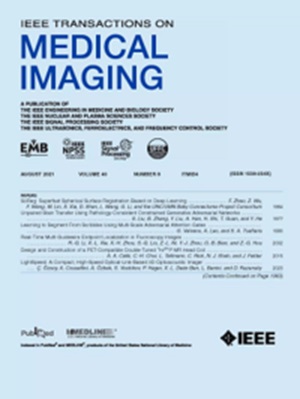Masked conditional variational autoencoders for chromosome straightening
IF 8.9
1区 医学
Q1 COMPUTER SCIENCE, INTERDISCIPLINARY APPLICATIONS
引用次数: 0
Abstract
Karyotyping is of importance for detecting chromosomal aberrations in human disease. However, chromosomes easily appear curved in microscopic images, which prevents cytogeneticists from analyzing chromosome types. To address this issue, we propose a framework for chromosome straightening, which comprises a preliminary processing algorithm and a generative model called masked conditional variational autoencoders (MC-VAE). The processing method utilizes patch rearrangement to address the difficulty in erasing low degrees of curvature, providing reasonable preliminary results for the MC-VAE. The MC-VAE further straightens the results by leveraging chromosome patches conditioned on their curvatures to learn the mapping between banding patterns and conditions. During model training, we apply a masking strategy with a high masking ratio to train the MC-VAE with eliminated redundancy. This yields a non-trivial reconstruction task, allowing the model to effectively preserve chromosome banding patterns and structure details in the reconstructed results. Extensive experiments on three public datasets with two stain styles show that our framework surpasses the performance of state-of-the-art methods in retaining banding patterns and structure details. Compared to using real-world bent chromosomes, the use of high-quality straightened chromosomes generated by our proposed method can improve the performance of various deep learning models for chromosome classification by a large margin. Such a straightening approach has the potential to be combined with other karyotyping systems to assist cytogeneticists in chromosome analysis.用于染色体拉直的掩蔽条件变分自动编码器
核型分析对于检测人类疾病中的染色体畸变具有重要意义。然而,染色体在显微镜图像中很容易出现弯曲,这阻碍了细胞遗传学家分析染色体类型。为了解决这个问题,我们提出了一个染色体矫正框架,该框架包括一个初步处理算法和一个称为掩码条件变分自编码器(MC-VAE)的生成模型。该处理方法利用斑块重排解决了低曲率的擦除困难,为MC-VAE提供了合理的初步结果。MC-VAE通过利用曲率条件下的染色体斑块来学习条带模式和条件之间的映射,进一步矫正了结果。在模型训练过程中,我们采用高掩蔽率的掩蔽策略来训练消除冗余的MC-VAE。这产生了一个重要的重建任务,允许模型在重建结果中有效地保留染色体带模式和结构细节。在三个具有两种染色风格的公共数据集上进行的大量实验表明,我们的框架在保留条带模式和结构细节方面优于最先进的方法。与使用真实世界的弯曲染色体相比,使用我们提出的方法生成的高质量的直染色体可以大大提高各种深度学习模型对染色体分类的性能。这种矫正方法有可能与其他核型系统相结合,以协助细胞遗传学家进行染色体分析。
本文章由计算机程序翻译,如有差异,请以英文原文为准。
求助全文
约1分钟内获得全文
求助全文
来源期刊

IEEE Transactions on Medical Imaging
医学-成像科学与照相技术
CiteScore
21.80
自引率
5.70%
发文量
637
审稿时长
5.6 months
期刊介绍:
The IEEE Transactions on Medical Imaging (T-MI) is a journal that welcomes the submission of manuscripts focusing on various aspects of medical imaging. The journal encourages the exploration of body structure, morphology, and function through different imaging techniques, including ultrasound, X-rays, magnetic resonance, radionuclides, microwaves, and optical methods. It also promotes contributions related to cell and molecular imaging, as well as all forms of microscopy.
T-MI publishes original research papers that cover a wide range of topics, including but not limited to novel acquisition techniques, medical image processing and analysis, visualization and performance, pattern recognition, machine learning, and other related methods. The journal particularly encourages highly technical studies that offer new perspectives. By emphasizing the unification of medicine, biology, and imaging, T-MI seeks to bridge the gap between instrumentation, hardware, software, mathematics, physics, biology, and medicine by introducing new analysis methods.
While the journal welcomes strong application papers that describe novel methods, it directs papers that focus solely on important applications using medically adopted or well-established methods without significant innovation in methodology to other journals. T-MI is indexed in Pubmed® and Medline®, which are products of the United States National Library of Medicine.
 求助内容:
求助内容: 应助结果提醒方式:
应助结果提醒方式:


